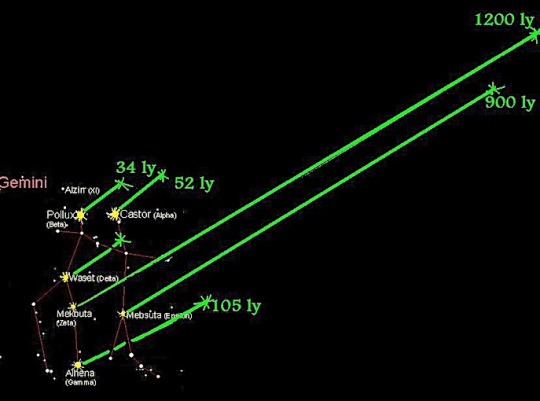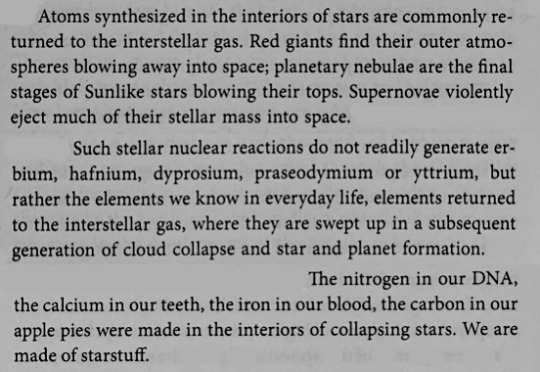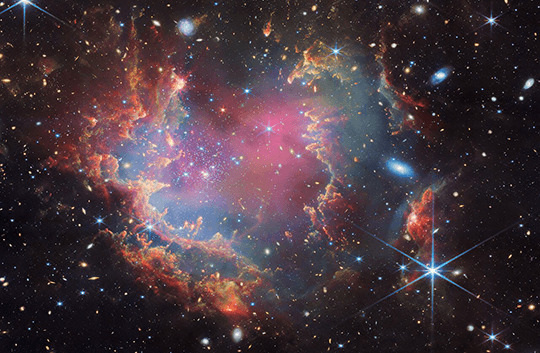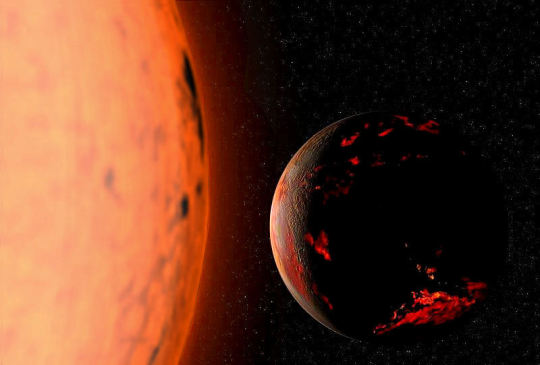#stellar evolution;;
Explore tagged Tumblr posts
Text
#this is their dynamic to me#transformers#trinefire#skystar#tf thundercracker#thundercracker#tf skywarp#Skywarp#tf starscream#Starscream#tf skyfire#skyfire#stellar evolution au#applies to it (in the future tho)#class jezter art
1K notes
·
View notes
Text
Interstellar Jets

This JWST image shows a couple of Herbig-Hero objects, seen in infrared. These bright objects form when jets of fast-moving energetic particles are expelled from the poles of a newborn star. (Image credit: NASA/ESA/CSA/STScI/JWST; via APOD) Read the full article
116 notes
·
View notes
Text
You know how Evoloution is the Youthful Naturalist's ambition?
I wonder if it'd be possible to rewrite it as if the Naturalist was a player doing a preset ambition. Like how someone plays, say, the "Bag a legend" ambtion etc.
I'll probably work on this the moment I get time because it seems like a fun project tbh.
#hahaheart1#fallen london#youthful naturalist#I have yet to finish evolution BUT#BUT#I am having a stellar time#And I've heard it's been called his ambition so like#We're the main companion? Very cool#I'd have to infer a lot of things from what's implied like what he's up to when we're doing other things#but it can be done#I will also have to make assumption on certain things especially since he'd be a POSI at the very least considering all the friends he has#and achivements he's completed#anywho#fun writing project#though I may need help on it haha#I also wonder if it's been done before#surely someone has done something like this yes?#eh#if I don't find anything then I'm good to go™
7 notes
·
View notes
Text
Stellar Evolution: An In-Depth Journey into the Lifecycle of Stars
Stellar evolution tells the fascinating story of how stars are born, change, and eventually die. It's a process that takes billions of years and has a big impact on the universe and even life itself. In this article, we'll explore the journey stars take throughout their lives, looking at the different stages they go through and what causes them. Let's dive into the details of stellar evolution and understand how these celestial objects live and evolve.
Formation of Stars: Birth from Cosmic Clouds
Stars begin their journey in huge clouds of gas and dust called nebulae. These clouds are like giant factories that have all the ingredients needed to make a star. When something like a shockwave or a disturbance happens, parts of the nebula start to get denser. This denser area is where a new star begins to form. It starts as what we call a protostar. As more and more material gets pulled in by gravity, the protostar grows bigger and denser. Eventually, it becomes so dense and hot that nuclear fusion starts happening in its core. This is when the star "turns on" and starts shining.
The Main Sequence Phase: A Star's Brightest Period
When a star begins nuclear fusion, it enters its main phase, which is its brightest time. In this phase, hydrogen atoms in the star's center combine to form helium, releasing a lot of energy. This energy pushes outward, balancing the star's gravity and, keeping it stable. How long this phase lasts depends on how big the star is. Bigger stars go through this phase faster than smaller ones.
Stellar Metamorphosis: Beyond the Main Sequence
Once a star runs out of its hydrogen fuel in the center, it starts changing and moves away from its main form. What happens next depends on how big the star is to begin with. Different-sized stars go through different changes, each with its own special things happening.
Red Giant Phase: The Stellar Expansion
When stars like our Sun start running out of hydrogen, they enter a phase called the red giant phase. At this point, the star gets bigger and expands outward, but its core gets smaller and hotter. This makes the outer layers of the star glow red. Inside the star, helium starts fusing together, creating even more energy. This red giant phase shows that the star is getting closer to the end of its life.
Planetary Nebulae and White Dwarfs
When a star becomes a red giant, it swells up and eventually sheds its outer layers into space. This creates a beautiful cloud called a planetary nebula. What's left behind is the core of the star, which becomes a white dwarf. A white dwarf is a small, dense object about the size of Earth. It's made mostly of a special kind of matter called electron-degenerate matter. Over a very long time, white dwarfs cool down and become less and less bright. Eventually, they become invisible and mark the end of the star's life for smaller stars.
Supernovae and Neutron Stars: The Fate of Massive Stars
When big stars run out of fuel, they collapse suddenly, causing a massive explosion called a supernova. This explosion is so bright that it can outshine entire galaxies. During this explosion, heavy elements made inside the star's core are scattered into space, which later helps in forming new stars.
After a supernova, the core of the big star can shrink even more, forming a neutron star. Neutron stars are very small, like cities, and are made mostly of tightly packed neutrons. They have strong magnetic fields and spin very fast, leading to interesting things like pulsars and magnetars.
Black Holes: The Mysterious End
When really big stars run out of fuel, something incredible happens. They collapse under their own gravity, squeezing down into a tiny, super-dense point. This creates something called a black hole. Black holes are mighty, with gravity so strong that not even light can escape from them. They're like cosmic vacuum cleaners, sucking in everything around them. Black holes are mysterious and fascinating, and they impact how galaxies work, shaping the universe in a really big way.
Conclusion
Stellar evolution is like a never-ending story of how stars are born and eventually fade away. It starts with the peaceful formation of baby stars in cloudy areas of space called stellar nurseries. Then, stars grow and shine brightly during their main life phase. But as they run out of fuel, some stars become red giants, swelling in size. Eventually, smaller stars become white dwarfs, while bigger ones explode into supernovae, scattering elements into space. This process helps shape the universe, showing us how everything in space is connected. By studying stars, we learn more about where we come from and our role in the vast cosmos.
FAQs
Who came up with stellar evolution? In the early 1900s, two astronomers named Ejnar Hertzsprung and Henry Norris Russell found a helpful way to compare different stars. They called it the Hertzsprung-Russell (H-R) Diagram. It's like a big chart where scientists can see how stars compare to each other based on their brightness and temperature. This diagram has been super useful in understanding more about stars and how they work.
What are the elements of stellar evolution? These are some of the building blocks found in space i.e. hydrogen, carbon, nitrogen, oxygen, phosphorus, sulfur, chlorine, sodium, magnesium, potassium, calcium, and iron.
What is the lifetime of a star? Very big stars burn through their fuel fast, so they don't live very long, maybe just a few hundred thousand years. But smaller stars use their fuel more slowly, so they can shine for billions of years. However, no matter how big or small a star is, eventually, it starts running out of hydrogen, which is what keeps it shining.
What is the stellar life cycle? Stars go through a cycle of being born, burning fuel, and spreading out material when they die. This cycle is ongoing and helps create elements that fill the universe. Depending on how much stuff a star has (its mass), it follows a different path in its life.
What are the 7 types of stars? Stars come in different types, and scientists classify them based on how hot they are. There are seven groups, starting with the hottest and ending with the coolest. They are named O, B, A, F, G, K, and M stars. O stars are the hottest and brightest, while M stars are the coolest and dimmest.
Read more
#science#astronomy#space#education#universe#physics#sol#sunspot#sunspot number#nebula#astrophotography#black holes#stars#stellar evolution#supernova#outer space#sky#night sky#cosmology
23 notes
·
View notes
Text
Prompt 27/2/25
The sun enters the next phase of it’s evolution early. Humanity has 100 years before the brightening sun makes the earth become uninhabitable.
#Science Fiction#creative writing#end of the world#fiction#space#stars#stellar evolution#sun#writing#writing inspiration#writing prompt
3 notes
·
View notes
Text
hello astronomy tumblr!!😁
so erm. im participating in science olympiad and i have to study stellar evolution (i think star formation specifically but i assume ill have to know the other stuff as well) and exoplanets but uhh i have NOT studied SHIT all year and regionals are in a month so. if anyone is knowledgeable in this area. please i need help i am begging anything helps if you dont know anything then tag like a friend who might idfk please i am desperate🙏🙏🙏
#science#astronomy#stellar evolution#star formation#stars#space#exoplanets#planets#science olympiad#help please#spread the word gang . i am going to humiliate myself guys please
14 notes
·
View notes
Text
dailymotion
Astrology is total crap, there's no getting around that. Nobody explained why in a more effective way than astronomer Carl Sagan.
Earth's precession (a type of natural wobble) and the proper motion of the stars themselves have changed the way we Earth people view the night sky in the 3,000 or so years since astrology was concocted. In fact, there are actually 13 rather than 12 constellations the sun appears in throughout the course of the year. And the dates the sun enters and leaves those constellations of the zodiac can be weeks off from what astrologers tell you.
And just because stars appear close to each other from our perspective on Earth does not mean they are actually close to each other in reality.
Here is a diagram of the brighter stars in Gemini. The ones labeled range from Pollux (Beta Geminorum) which is an estimated 34 light years away to Mekbuta (Zeta Geminorum) which is about 1200 light years away. BTW Wasat (Delta Geminorum), which they forgot to number, is 60 light years away.

So a constellation is not some sort of special conclave of stars, it's a random collection which simply appears in the same patch of the sky as seen from Earth. The same is true of the other constellations – not just Gemini.
So your destiny has nothing to do with the changing positions of the stars and planets. Sorry! But we do all share a far more concrete connection to the universe.
All the elements except for hydrogen, helium, and (a tiny bit of) lithium were created inside of stars which blew up or ejected much of their contents billions of years ago.
I edited together a few sentences from the companion volume for the COSMOS series which the vid above comes from.

So yeah, the universe is inside all of us. That's our true connection to the cosmos.
13 notes
·
View notes
Text
does anyone else use their imagination to visualise what you’re reading about so completely that finishing reading feels like waking up
#was reading about stellar evolution this morning#then looked up and suddenly was confronted with the realisation#that I wasn’t in fact watching a star leave the main sequence#personal
8 notes
·
View notes
Text
In-depth look at Eevee ex, Budew and Regigigas from Pokémon TCG: Scarlet & Violet—Prismatic Evolutions
Read on below to learn more about a new Pokémon TCG: Scarlet & Violet expansion: Pokémon TCG: Scarlet & Violet—Prismatic Evolutions Top Competitive Cards Get an in-depth look at the adorable Eevee ex, the brilliant Budew, and the remarkable Regigigas. By Ellis Longhurst, Contributing Writer Light up the battlefield with cards from the Pokémon Trading Card Game: Scarlet & Violet—Prismatic…
#Budew#Eevee#Eevee EX#Ellis Longhurst#Espeon#Flareon#Glaceon#Jolteon#Leafeon#Pokémon TCG: Pokémon Scarlet & Pokémon Violet#Pokémon TCG: Pokémon Scarlet & Violet#Pokémon TCG: Scarlet & Violet#Pokémon TCG: Scarlet & Violet—Prismatic Evolutions#Pokemon#Pokemon Blog#Pokemon news#Pokemon TCG#Pokemon Trading Card Game#Pokemon-EX#Prismatic Evolutions#Regigigas#Scarlet#Scarlet & Violet#Scarlet & Violet—Prismatic Evolutions#Stellar Tera Pokémon ex#Sylveon#TCG#The Pokemon Company#The Pokemon Company International#Umbreon
1 note
·
View note
Note
I'm new and not quite sure what's going on yet, but my heart goes out to the megastar fix-it-baby.
sorry that's your life, girl. Damn
Thanks! It all started at the age of two hours old

#transformers#stellar evolution au#tf supernova#tf megatron#tf starscream#megastar#transformers oc#tf oc#class jezter art
1K notes
·
View notes
Text
A Stellar Look at NGC 602

The young star cluster NGC 602 sits some 200,000 light years away in the Small Magellanic Cloud. Seen here in near- and mid-infrared, the cluster is a glowing cradle of star forming conditions similar to the early universe. (Image credit: NASA/ESA/CSA/JWST; via Colossal) Read the full article
97 notes
·
View notes
Text
Interview: Aaron Lee Tasjan
#Interview: @aaronleetasjan1 The beloved #indie #troubadour discusses his #tour behind his new album STELLAR EVOLUTION and his forthcoming #LA show @BigFeatPR @blueelanrecords @moroccan_lounge #newmusic #livemusic #folk #rock #pop #musicrecommendation
Aaron Lee Tasjan is one of those artists that your favorite artists gush over. A masterful songsmith, able to traverse genres and styles with ease, he’s also an empowering voice in the LGBTQ community and activist who uses his voice to create safe spaces for those who have felt like outsiders in their communities. On his latest album Stellar Evolution, Tasjan mines his own past struggles as well…

View On WordPress
#Aaron lee tasjan#folk#indie#indie rock#interview#Moroccan Lounge#New Music#pop#rock#singer songwriter#Stellar Evolution
2 notes
·
View notes
Text
stars are like my least favorite astronomical object (so sorry, controversial i know) and so i’m only just sitting here realizing that like stars, as a general topic, is so complex wtf. stellar classification all on its own is a whole thing with many different ways to categorize stars (harvard spectral classes, mk luminosity classes, HR diagram, stellar populations, etc), nevermind stellar evolution, including formation and death, and then stellar spectra and the physics behind that, and then the like actual physical anatomy of the sun and heliophysics, space weather, etc? and the nuclear physics behind fusion? what the fuck man
#ive always been more into cosmology and that mostly just deals with galaxies#i love galaxies !#i took a whole class on stars and it was when i was at rock bottom mentally so i really did not retain anything from it#but i do fucking know we never learned how to actually classify stars#like the basic spectral classes#so sitting here throughout today trying to relearn and reteach myself starting from 0 its like wait i never formally learned this anyway??#most of the class was on stellar evolution 😩😩#like idk i think stars are theoretically cool like oh big giant massive star go boom supernova wow so cool#but like theres. so fucking much physics behind all that its really quite snore actually. idk i think stars are overrated 💁#fucking pp chain vs cno cycle#UGH add nuclear physics onto this list too#meanwhile my whole class about galaxies was just like tee hee. Galaxies#brot posts#astro posting
4 notes
·
View notes
Text

i'm feeling very normal about my studies
2 notes
·
View notes
Text

“In about one billion years, the solar luminosity will be 10% higher, causing the atmosphere to become a ‘moist greenhouse’, resulting in a runaway evaporation of the oceans. As a likely consequence, plate tectonics and the entire carbon cycle will end. Following this event, in about 2–3 billion years, the planet's magnetic dynamo may cease, causing the magnetosphere to decay and leading to an accelerated loss of volatiles from the outer atmosphere. Four billion years from now, the increase in Earth's surface temperature will cause a runaway greenhouse effect, creating conditions more extreme than present-day Venus and heating Earth's surface enough to melt it. By that point, all life on Earth will be extinct. Finally, the most probable fate of the planet is absorption by the Sun in about 7.5 billion years, after the star has entered the red giant phase and expanded beyond the planet's current orbit.”
Wikipedia contributors, "Future of Earth" (Sep 11, 2023).
#extinction#solar luminosity#stellar evolution#solar evolution#red giant phase#heliophysics#astronomy#indexmiscellany
2 notes
·
View notes
Text
You may know that black holes are what happens to stars after they go supernova, but only some stars do. Black holes are the result of extremely massive stars exploding at the end of their life cycles. But why is that? Why does this only happen to big stars? To answer that, we'll have to take a look at how stars form in the first place.
Stars begin their lives as clouds of hydrogen gas. Those floating hydrogen atoms exert gravity on each other, and as they come together, their cloud gets denser and denser. The hydrogen atoms orbit around each other and so the cloud itself begins to spin. Eventually this hydrogen gets dense enough that it forms a core, and the atoms get in real tight with one another and they compress. When you compress a material, it actually heats up, and when this ball of hydrogen gets dense and hot enough the atoms begin to fuse with one another and a baby star is formed! This is called a protostar. It continues to contract and become brighter and hotter. Eventually it stabilizes into a "main sequence" star. This is the kind of star the sun is.
When atoms fuse together, the byproduct is a new atom. Since hydrogen has one proton and one electron, this new atom has two protons and two electrons: helium. Helium is heavier than hydrogen, so as the fusion process continues this helium falls to the center of the star, due to gravity, and forms a core. So you have a non-fusing helium core with a shell of hydrogen fusing around it. This core gets bigger and bigger, eating up more of the hydrogen, and pushing the remaining hydrogen outward. So the star expands, and it enters its next phase of life: a red giant.
This whole time gravity is compacting that helium core denser and denser, just like it did with hydrogen in the beginning. At this point, either the star will burn out as it consumes the last of its hydrogen or, if it's big enough, the helium core will get dense and hot enough to fuse on its own! This is called a "helium flash" and at this point the star will stabilize again into a stage of its life similar to its main sequence stage, but this time burning helium.
This process repeats itself. As the helium burns, it fuses into carbon, which falls to the core of the star and starts to become dense itself. Depending on the size of the star, this could repeat a few times. Supergiant stars can even do this enough that they fuse their atoms into silicon or even iron.
At this point, the elements in the core are too heavy to fuse in this way. When they compress enough to fuse again, the result is explosive, and we get our supernova event. The outer shell of the star blows clean off, and when this happens it spews the new elements its created out into the cosmos. You know how people say we're made of "star stuff" or "stardust"? They're right, and this is how it happens. This is where all the heavier elements are made.
But for every action, there is an equal and opposite reaction.
When the outer shell gets blown off, an equal and opposite force pushes the remaining core inward, making it even more dense! If it's a small star, and didn't have a lot of mass (comparatively), this super dense core remains, smoldering with what remains of the heat from the explosion. We call this a white dwarf. Stars with more mass explode with enough force to compress their cores far enough that they show strange quantum-mechanical properties, and we call these neutron stars. Neutron stars are really interesting and deserve their own post.
But if the star was massive enough, this blowback compresses the core to the point where its volume effectively becomes 0. Now, if you remember that Density = Mass / Volume, and you know that you cannot divide by zero, you can see that there is a bit of a problem. This explosion collapses the core so hard that it breaks spacetime. This "divide by zero error" is what we call a singularity, and becomes the center of a black hole. See, the mass of the black hole doesn't change, but its density becomes infinite. We'll talk about what that means in the next post.
#science#astronomy#black hole#space#physics#astrophysics#also its important you know that the stellar evolution section in astro 101 made me cry#like literally#and now its one of my favorite things to talk about
3 notes
·
View notes